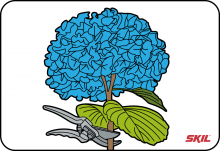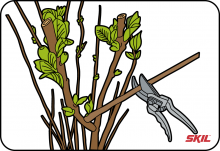-
What tool do you need to prune your hydrangeas?
Pruning hydrangeas is fairly easy. You can use secateurs with a parrot beak to prune the hydrangeas’ flowers and branches. -
How should you prune your hydrangeas?
Hydrangeas that bloom on old buds are pruned by cutting off the dead heads just above the top pair of thick, healthy buds. Give hydrangeas that bloom on old heads extra protection from night frost to ensure the new flower heads don't freeze. You do this by covering the shrub with a horticultural fleece or bubble wrap. Remove the fleece or wrap as soon as the frost has gone.
You don’t need to prune the dead heads of hydrangeas that bloom on new buds in the autumn. The new flowers develop on the same branch under the dead heads, which protect the new flowers from frost. The dead flowers can be cut in the early spring to make room for the new flowers.


